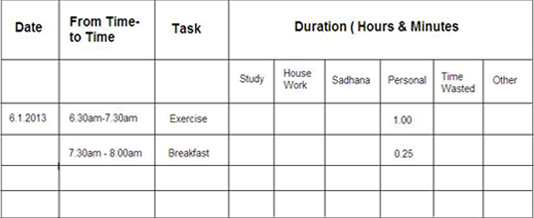1. Look of daily diary
Daily diary normally should have the following columns:

Parents can be consulted to do any changes in columns.
2. How to write a diary ?
While writing a diary, begin with writing Tithi or date. In the next column, i.e. ‘From Time – To Time’, enter time slots (e.g.. 6.30 am to 7.00 am, 7.00 am to 7.30 am) one below the other. In the next column ‘Task’, write task completed for each time slot (e.g. exercise, breakfast). In the rest of the columns, write actual duration (hours/minutes) for each task, e.g. time taken to do exercise , bath should be entered in a personal column as 30 minutes, 40 minutes respectively.
Like this, for the entire day, enter each task and duration taken to complete each task. If any task not listed is done, enter time spent on it in ‘Other’ column. Update the diary as soon as task is completed. This helps in writing a perfect diary and for the mind to realize to use time effectively. If diary is written at night, a lot of time is wasted in recollecting what was done and at what time.
3. Enter time wasted for each task in a diary
While writing a diary, study actual time spent for each task. If any task has taken more time than required, then enter extra time taken in the column ‘Time Wasted’, e.g. If you have spent 7.30 am to 9.00 am in doing your personal work like combing hair, bath and the time that was expected to spend was 1 hour, then enter ’30 minutes’ in the column ‘Time Wasted’ . Like this, enter wastage of time for each task. Before going to sleep, add duration, starting from the column ‘Study’ to the last column. This will help in realizing how much time is spent on study, sports and how much time got wasted and where it got wasted. Show your diary regularly to your parents.

 Early to bed and early to rise, makes a man healthy, wealthy and wise !
Early to bed and early to rise, makes a man healthy, wealthy and wise ! Do this after bathing in the morning
Do this after bathing in the morning Do this at twilight
Do this at twilight Etiquettes for meals
Etiquettes for meals Offer obeisance to parents and elders
Offer obeisance to parents and elders Making guests feel welcome in your home
Making guests feel welcome in your home